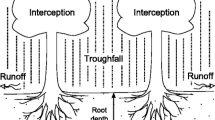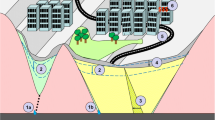Abstract
Of the recognized nonsteady-state factors that influence slope stability, probably most critical in many field situations is the character of precipitation and infiltration activity. A groundwater response model used in conjunction with precipitation records can provide a historical catalog of estimated maximum groundwater levels in a particular study area. An extreme-value statistical analysis of this catalog is linked with geotechnical slope stability analyses to provide a landslide hazard model for estimating the probability of slope failure within a given time. This modeling approach can provide meaningful input to risk assessments for landslide mitigation programs and to decision analyses and cost-benefit studies important for land-use planning and resource management.
Similar content being viewed by others
References
Carr, J. R. and Bailey, R. E., 1986, An Indicator Kriging Model for Investigation of Seismic Hazard: Math. Geol., v. 18, p. 409–428.
Gumbel, E. J., 1958, Statistics of Extremes: Columbia University Press, New York, 375 p.
Kinnison, R. R., 1985, Applied Extreme Value Statistics: Battelle Press, New York, 149 p.
Kirsten, H. D. and Moss, A. S. E., 1985, Probability Applied to Slope Design—Case Histories,in C. H. Dowding (Ed.), Rock Masses—Modeling of Underground Openings/Probability of Slope Failure/Fracture of Intact Rock: ASCE, New York, p. 106–121.
Miller, S. M., 1984, Probabilistic Rock Slope Engineering: Paper no. GL-84-8: Geotechnical Lab, USAE Waterways Experiment Station, Vicksburg, Mississippi, 75 p.
Miller, S. M. and Borgman, L. E., 1984, Probabilistic Characterization of Shear Strength Using Results of Direct Shear Tests: Geotechnique, v. 34, p. 273–276.
Neuman, S. P.; Feddes, R. A.; and Bresler, E., 1974, Finite Element Simulation of Flow in Saturated-Unsaturated Soils Considering Water Uptake by Plants: Hydrodynamics and Hydraulic Engineering Laboratory, Israel Institute of Technology, Haifa, Israel.
Newendorp, P. D., 1975, Decision Analysis for Petroleum Exploration: Petroleum Publishing Company, Tulsa, Oklahoma, 668 p.
Prellwitz, R. W. and Babbitt, R. E., 1984, Long-term Groundwater Monitoring in Mountainous Terrain: Paper presented at 63rd Annual Meeting of the Transportation Research Board: Washington, DC, January.
Prickett, T. A. and Lonnquist, C. G., 1971, Selected Digital Computer Techniques for Groundwater Resource Evaluation, Bull. 55: Illinois State Water Survey, Urbana, Illinois, 62 p.
Sangrey, D. A.; Harrop-Williams, K. O.; and Klaiber, J. A., 1984, Predicting Groundwater Response to Precipitation: Jour. Geotech. Eng. ASCE, v. 110, p. 957–975.
Soong, T. T., 1981, Probabilistic Modeling and Analysis in Science and Engineering: John Wiley & Sons, New York, 384 p.
Ward, T. J.; Li, R. M.; and Simons, D. B., 1979, Mathematical Modeling Approach for Delineating Landslide Hazards in Watersheds,in Proceedings of the 17th Annual Symposium on Engineering Geology and Soils Engineering: Moscow, Idaho, p. 109–142.
Author information
Authors and Affiliations
Rights and permissions
About this article
Cite this article
Miller, S.M. A temporal model for landslide risk based on historical precipitation. Math Geol 20, 529–542 (1988). https://doi.org/10.1007/BF00890335
Received:
Accepted:
Issue Date:
DOI: https://doi.org/10.1007/BF00890335




